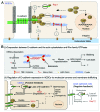Role of E-cadherin and other cell adhesion molecules in survival and differentiation of human pluripotent stem cells
- PMID: 22647941
- PMCID: PMC3364139
- DOI: 10.4161/cam.19583
Role of E-cadherin and other cell adhesion molecules in survival and differentiation of human pluripotent stem cells
Abstract
The survival, proliferation, self-renewal and differentiation of human pluripotent stem cells (hPSCs, including human embryonic stem cells and human induced pluripotent stem cells) involve a number of processes that require cell-cell and cell-matrix interactions. The cell adhesion molecules (CAMs), a group of cell surface proteins play a pivotal role in mediating such interactions. Recent studies have provided insights into the essential roles and mechanisms of CAMs in the regulation of hPSC fate decisions. Here, we review the latest research progress in this field and focus on how E-cadherin and several other important CAMs including classic cadherins, Ig-superfamily CAMs, integrins and heparin sulfate proteoglycans control survival and differentiation of hPSCs.
Figures

References
Publication types
MeSH terms
Substances
Grants and funding
LinkOut - more resources
Full Text Sources
Other Literature Sources
Research Materials
